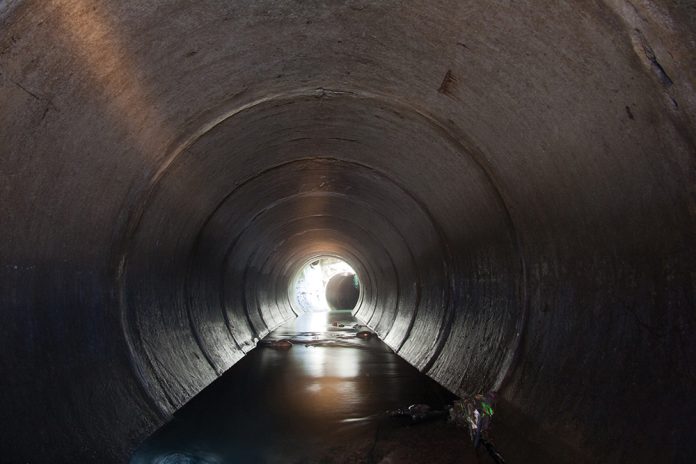Wessex Water’s Rehabilitation Manager Julian Britton discusses how the company has used innovative trenchless technology to renovate sewers.
Wessex Water was an early adopter of renovating sewers using trenchless technology and assisted the Water Research Centre (WRc) in their compilation of the Sewerage Rehabilitation Manual (first edition) in 1980, later published in 1983.
Our participation saw the lining of ovoid sewers across the railway station car park in Weston-super-Mare, with Type 1 GRP liners, which were purposely crushed to destruction to understand the failure and buckling moments, and hence the calculations to design future linings.
In 2004, a dedicated Sewer Rehabilitation team was formed, with the company’s aim of driving forward innovation by:
reducing open-cut repair interventions and mitigating the impact of our work on customers and commuters, which is achieved by using methods that prevent the need for over 30,000 muckaway lorries on our streets per year
reducing unit rate costs of renovation, which now stand at 75% less than open cut equivalents, when we utilise ‘Cured in Place Pipelining’ (CIPP)
calculating and reducing our carbon footprint through trenchless works when using CIPP, now equating to 95% less CO2 production over traditional open cut.
Numerous awards have been won by the team, including the International Society of Trenchless Technology’s (ISTT) ‘Innovation Award’ in Rome (2007) for our work on polyacrylate joint sealing to prevent groundwater infiltration. We also won the same ISTT ‘Innovation Award’ in Toronto (2009) for our collaborative development of the world’s first ‘Melt in Place Pipelining system’.
Surveying sewers and tunnels
Information gathering commences any scheme with CCTV surveys, and the most difficult surveys are those in our large diameter tunnels up to 5m in diameter, with high velocities of flow, where access can be up to 90m deep and shafts 1000m apart. We wanted to develop a robust LiDAR-based survey platform, which could mathematically discount for the semi turbulence of flow, without the need for a gimbal, providing a steady-state 3D model with high levels of accuracy. A survey platform with over 4000m of reach in one insertion.
We commissioned a new start-up company in this field of expertise, Headlight AI Ltd and associates, Bright Innovations Group, who develop technologies for the sensing and assessment of such harsh environments. The data collected was processed to account for the motion of the system and utilised Artificial Intelligence (AI) to obtain insights into the sewer’s condition and identify defect locations faster and more accurately.
The benefit of the system is that all required scanners and attached still 360-degree photographic rendering of the model are housed on the vehicle, without the need for an umbilical electrical power supply back to the surface, and more importantly, without the need to introduce operatives into such dangerous environments. The system was named ‘Telesto’.
Unlike other Dense Point Cloud tunnel surveys using LiDAR, Telesto does not require ‘targets’ placed along the line of the sewer (which would require man entry) for model control. Thus, the Telesto method provides a greater level of information at a lower cost (greater than 50% lower on average) than person entry solutions.
Wessex Water’s objective is to undertake an iterative series of surveys over their tunnel portfolio in the coming years to compare any deterioration of the tunnel intrados due to corrosion, diminution of wall thickness, or change in profile due to structural movement.
Telesto will also benefit through the automated nature of the technology, which will save us significant time in data processing. This will avoid the need for engineers to study and grade surveys and other data for long periods of time. Eventually, the development of our separate initiative to refine integrated defect recognition algorithms, which Wessex Water is currently exploring through our ‘Marketplace’ initiative, will increase appraisal productivity, allowing computers to take on laborious coding, with only a cursory intervention via human auditing.
Rehabilitating collapsing sewers
The transfer of private drainage to Wessex Water in 2012 saw our sewerage system increase in length to 35,000km, most of which are 150mm diameter pipes. The main reason is CIPP, where we line sewers with resin-impregnated felt or glass fibre linings, which we cure in place with heat or light. Once cured, the lining becomes a ‘pipe within a pipe’, designed to last for anywhere between 50 and 100 years.
Unfortunately, in terms of the structural stability of the cured lining, we have additional design and installation considerations for those 150mm sewers with a deformation greater than 10% of the host pipe diameter. Beyond or greater than this, the ‘bending moments’ become larger, the thickness of the lining increases, and we often cannot mobilise the liner into the sewer, or it is so thick that it reduces the hydraulic conductivity of the pipe beyond reasonable limits.
Wessex Water has designed and manufactured a robotic machine for re-rounding (patent pending) deformed 150mm diameter sewer pipes, which have suffered up to 25% deformation on diameter. The machine is versatile and can be used with rigid clay or concrete sewer pipes as well as pitch fibre pipes. Once the pipe has regained its original rounded shape, a metal stent is placed to secure the structural integrity of the pipe, until CIPR Patching or CIPP Lining can be achieved.
Commenting upon our 17 years of technical evolution, Hollie Sharratt, Commercial Manager for the Construction Division, said: “Trenchless solutions have made a significant impact on how Wessex Water review and repair our assets. It provides a fast, effective, sustainable and affordable approach, which leads us to providing better value for our customers with less disruption.
“Trenchless solutions will continue to be developed and invested in as we face further challenges including a changing climate and increasing population.”
Fundamentally, as owner of the sewerage networks asset, Wessex Water recognises the ‘needs’ to be addressed, and is best suited to search for solutions worldwide and/or innovate trenchless techniques where necessary.



